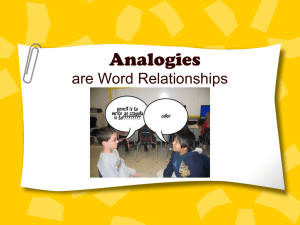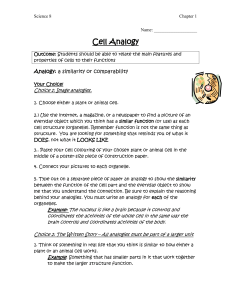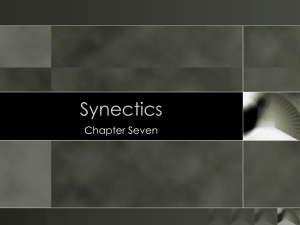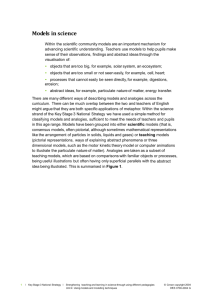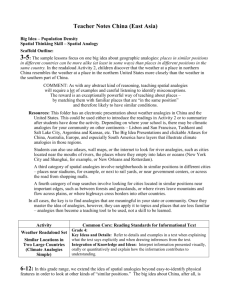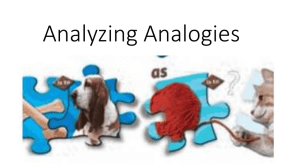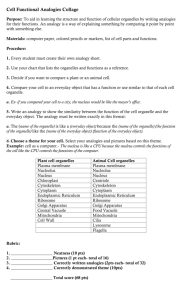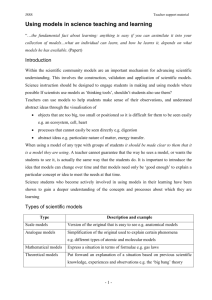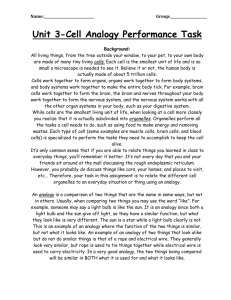GENERAnVECAFACr{OFANALOGIE5 1261
advertisement
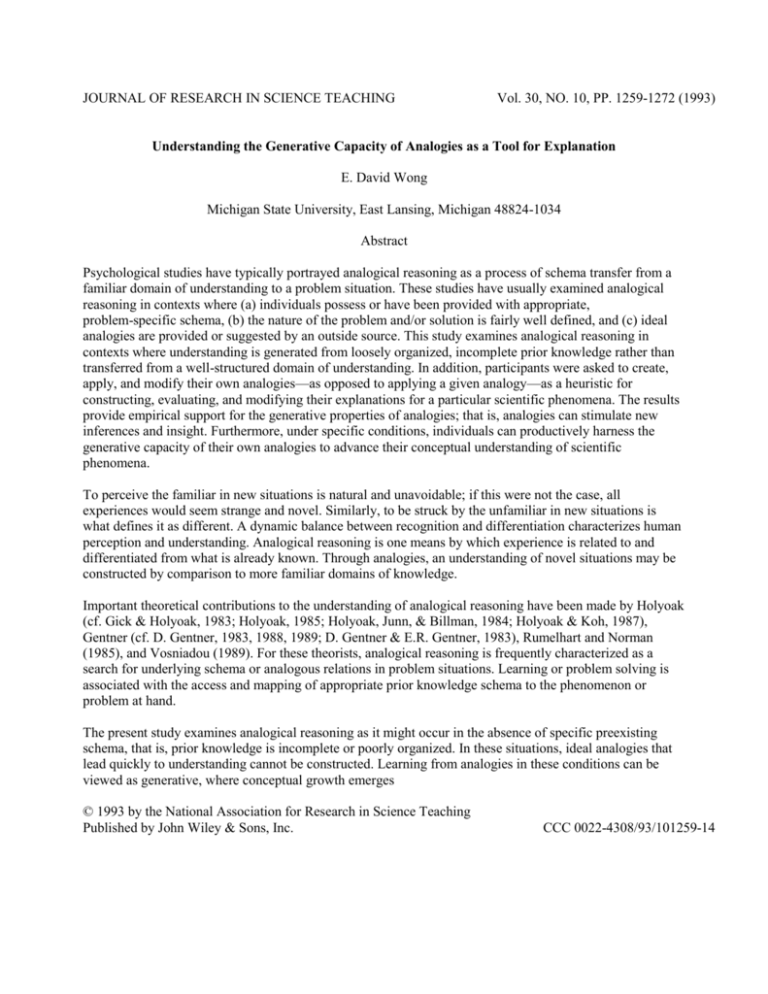
JOURNAL OF RESEARCH IN SCIENCE TEACHING Vol. 30, NO. 10, PP. 1259-1272 (1993) Understanding the Generative Capacity of Analogies as a Tool for Explanation E. David Wong Michigan State University, East Lansing, Michigan 48824-1034 Abstract Psychological studies have typically portrayed analogical reasoning as a process of schema transfer from a familiar domain of understanding to a problem situation. These studies have usually examined analogical reasoning in contexts where (a) individuals possess or have been provided with appropriate, problem-specific schema, (b) the nature of the problem and/or solution is fairly well defined, and (c) ideal analogies are provided or suggested by an outside source. This study examines analogical reasoning in contexts where understanding is generated from loosely organized, incomplete prior knowledge rather than transferred from a well-structured domain of understanding. In addition, participants were asked to create, apply, and modify their own analogies—as opposed to applying a given analogy—as a heuristic for constructing, evaluating, and modifying their explanations for a particular scientific phenomena. The results provide empirical support for the generative properties of analogies; that is, analogies can stimulate new inferences and insight. Furthermore, under specific conditions, individuals can productively harness the generative capacity of their own analogies to advance their conceptual understanding of scientific phenomena. To perceive the familiar in new situations is natural and unavoidable; if this were not the case, all experiences would seem strange and novel. Similarly, to be struck by the unfamiliar in new situations is what defines it as different. A dynamic balance between recognition and differentiation characterizes human perception and understanding. Analogical reasoning is one means by which experience is related to and differentiated from what is already known. Through analogies, an understanding of novel situations may be constructed by comparison to more familiar domains of knowledge. Important theoretical contributions to the understanding of analogical reasoning have been made by Holyoak (cf. Gick & Holyoak, 1983; Holyoak, 1985; Holyoak, Junn, & Billman, 1984; Holyoak & Koh, 1987), Gentner (cf. D. Gentner, 1983, 1988, 1989; D. Gentner & E.R. Gentner, 1983), Rumelhart and Norman (1985), and Vosniadou (1989). For these theorists, analogical reasoning is frequently characterized as a search for underlying schema or analogous relations in problem situations. Learning or problem solving is associated with the access and mapping of appropriate prior knowledge schema to the phenomenon or problem at hand. The present study examines analogical reasoning as it might occur in the absence of specific preexisting schema, that is, prior knowledge is incomplete or poorly organized. In these situations, ideal analogies that lead quickly to understanding cannot be constructed. Learning from analogies in these conditions can be viewed as generative, where conceptual growth emerges © 1993 by the National Association for Research in Science Teaching Published by John Wiley & Sons, Inc. CCC 0022-4308/93/101259-14 1260 WONG | from a continual refinement and synthesis of fragmented, incomplete knowledge. In addition, in most prior studies, participants have reasoned about analogies that were prompted or provided by the researchers. The role of self-generated analogies—where the analogy is constructed by someone who does not yet understand the phenomenon that the analogy is supposed to help clarify—is examined in this study. The central research questions for this study were 1. Can a task be developed that fosters conceptual growth through generative analogies? 2. What is the nature of conceptual growth that occurs? 3. How do analogies facilitate conceptual growth? Analogical Reasoning as Mapping from Preexisting Schema The work of Gick and Holyoak has contributed to an understanding of the conditions that facilitate the induction and application of particular analogies in problem situations (cf. Gick & Holyoak, 1983; Holyoak & Koh, 1987). In their study, participants were asked to solve the Duncker radiation problem: Suppose you are a doctor faced with a patient who has a malignant tumor in his stomach. It is impossible to operate on the patient, but unless the tumor is destroyed the patient will die. There is a kind of ray that can be used to destroy the tumor. If the rays reach the tumor all at once at a sufficiently high intensity, the tumor will be destroyed. Unfortunately, at this intensity the healthy tissue that the rays pass through on the way to the tumor will also be destroyed. At lower intensities, the rays are harmless to healthy tissue, but they will not affect the tumor either. What type of procedure might be used to destroy the tumor with the rays, and at the same time avoid destroying the healthy tissue? (Gick ~ Holyeak, 1983) The solution to the problem involved the use of multiple weak X rays converging on the tumor. The solution to this problem was deliberately analogous to a story presented earlier to the participants. This story described a fortress under siege. The fortress was protected by bridges that would explode if too many enemy troops were to cross them at once, thereby preventing large-scale attacks over any one bridge. In the end, the fortress was successfully captured when several small troops crossed multiple bridges and converged on the fortress simultaneously. Solving the medical problem required accessing and applying the "convergence" schema established by the analogous fortress problem. The Gick and Holyoak work characterized analogical reasoning as a process of mapping knowledge from a source domain of understanding to the target domain or problem situation (for other examples of a mapping perspective, see Collins & Burstein, 1989; Rumelhart & Norman, 1983; Sternberg, 1977; Vosniadou, 1989). Solving the problem required the individual to recognize specific similarities and to construct the appropriate analogous relations between the source and target domains. The data suggested that analogical reasoning was facilitated by two factors: a well-developed convergence schema in prior knowledge, and the ability to recognize the target (problem situation) as an instance of the convergence schema. Problem solving was implicitly equated with the applying of the specific prior knowledge schema. Interestingly, in the Gick and Holyoak study, 10% of the participants were able to solve the Duncker radiation problem without having been taught the ideal convergence schema beforehand. These spontaneous solutions suggest that learning and problem solving might have also occurred in the absence of the a priori, well-developed, problem-specific schema. Similarly, in many other problem situations in and out of school settings, individuals will often successfully GENERATIVE CAPACITY OF ANALOGIES 1261 solve problems or construct understandings in conditions where they lack well-developed, problem-specific, preexisting knowledge schema. Understanding, therefore, is necessarily constructed from bits and pieces of fragmented, incomplete knowledge. The Gick and Holyoak research suggests that an understanding of analogical reasoning might be advanced by examining how learning or problem solving might occur in the absence of well-developed knowledge schema. Generative Analogical Reasoning Another major contribution to the study of analogical reasoning has been Gentner's structure mapping theory (Gentner, 1983). This theory proposes a system of procedures and implicit rules by which analogies are created and understood. These rules depend on the syntactic properties of the knowledge representation; that is, the relationships between objects or terms provides the basis for analogical mapping. For example, because the relationship between an atom's nucleus and its electrons is similar to the relationship between the sun and its planets, the analogy "the atom is like the solar system" makes sense. The soundness of analogies can be evaluated by inspecting the degree that deep structure relations between the two domains, as opposed to surface similarities, form a basis for the analogical comparison. For example, an analogy comparing a tire to a shoe on the basis that both are black would be judged less appropriate than an analogy emphasizing that both are used to cover terrain (Gentner, 1988). Structure mapping theory also begins to offer an explanation for how conceptual growth might occur through analogical reasoning. When analogies are constructed, similar features or relations are mapped from the source to the target domain (e.g., both the solar system and the atom involve revolving particles). In addition, carryover may occur from one domain to another; that is, when an analogy is constructed, similarities may be inferred that were not originally apparent when the analogy was first considered (Gentner, 1989). For example, in the process of constructing the sun/atom analogy, the individual may conjecture that there might be a gravitational attraction between an electron and the nucleus just as there is between a planet and the sun. These features that are carried over represent new knowledge and may be based on correct or incorrect inferences. To test these generative qualities of analogical reasoning, Gentner and Gentner (1983) observed high school and college students as they used two different analogies to explain and solve problems about the flow of electricity (analogies: the flow of electricity is like flowing water, or the flow of electricity is like teeming crowds of people). As participants solved problems about electric circuits during the task, their explanations were characterized by distinct and predictable strengths and weaknesses that could be attributed to the generative capacity of the analogy they were using. Facilitating Generative Analogies Gentner's work provides a compelling example of how reasoning with analogies can facilitate knowledge growth by enabling the individual to generate new inferences. In related work, Spiro, Feltovich, Coulson, and Anderson (1989) examined how analogies used by college students to understand biological phenomena often led to unwanted misconceptions. Students tended to overextend analogies by making inferences that led to scientifically incorrect explanations. Although the students' understanding of the concepts was sometimes misdirected, the generative capacity of the analogies was evident. Spiro et al. argued that the deficiencies of single analogies could be addressed through the use of multiple analogies during instruction. 1262 WONG Analogies should be carefully chosen and integrated to mutually negate weaknesses and to convey the nature and complexity of the subject matter. - Fostering Learner-Directed Generative Analogical Reasoning. The use of multiple, inte grated analogies represents a promising means by which the generative power of analogies might be constructively harnessed in instructional situations. The present study examines how generative analogies might be created by the learners themselves in situations where minimal outside, expert assistance is available. In most research on analogical reasoning to date, a problem is typically defined by the researcher and assumed to have a correct solution or explanation. In addition, the analogy—the target and source domains—is usually provided or implicitly suggested to the participant by the researchers. (For a notable exception, see the Clement, 1988, study where the problem-solving methods of physics experts was observed. In several instances, participants created their own analogies or comparisons as a tool for thinking about the given physics problem.) Analogical reasoning, however, is not confined to carefully controlled instructional settings. Efforts to understand and foster independent learners— individuals who can intentionally and carefully construct their own understandings in and out of school settings—might be informed by research on learner-directed generative analogical reasoning. When moving from teacher/researcher-directed to learner-directed analogical reasoning, the learner assumes primary responsibility for creating analogies. In the absence of an expert's overarching understanding of the nature of the phenomena, how will the learner be able to discern which analogies are most appropriate? In these situations, the learner must consider that all analogies are faulty in some respects and that no analogy will completely and accurately represent the nature of the phenomenon. This assumption necessitates that learners must (a) deliberately evaluate their own analogies by identifying both similarities and differences between the two domains, and (b) construct a series of analogies in a continuous effort to address the deficiencies of prior analogies. Other important features of learner-directed generative analogical reasoning—as defined in this study— include: (a) reasoning about phenomena for which prior knowledge is poorly organized and incomplete, rather than about phenomena where well-developed schema exist; (b) addressing problems determined primarily by the learners themselves, rather than an outsider; (c) conceptualizing analogies as a tool for knowledge growth, rather than as a representation of a correct explanation or problem solution; and, of course, (d) expecting that analogies are created by the learners themselves, rather than provided by an outsider. Methods Participants. ELleven secondary school teacher candidates (four men, seven women) from the teacher education program at a major university were recruited to participate in the study. Participants did not receive academic credit or monetary reimbursement for their involvement. Participants were recruited from a variety of different subject-matter areas (physics, chemistry, geology, biology, foreign language, English) to provide a range of prior knowledge for the task phenomena. The Task. Participants were presented with a piston/cylinder device (a large 50-cc syringe) that demonstrated the fol]owing three air-pressure phenomena: As the plunger is pushed into the GENERATIVE CAPACITY OF ANALOGIES 1263 Three phcuomena: Compression: as the plunger is pushed into the syringe, the amount of force required to move the plunger increases. Decompression: as the plunger is pulled out of the syringe, the amout of force required to move the plunger increases. Return: when the plunger is released after being pushed or pulled, it returns toward its initial position. Figure 1. Device used to demonstrate air pressure phenomena syringe with the nozzle covered by a finger, the amount of force required to move the plunger increases (compression); as the plunger is pulled out of the syringe with the nozzle still covered, the amount of force required to move the plunger increases (decompression); when the plunger is released after being pushed or pulled, it returns toward its initial position (return). (See Figure 1.) Participants were told that the purpose of the study was to examine how they came to produce and modify explanations about scientific phenomena. The directions for the task stressed that the aim of the task was not to identify whether their explanations were "correct" or not. Instead, their ideas and methods for constructing explanations about the phenomena were of principal interest. In the first part of the task, participants were asked to explain the three air-pressure phenomena. Then, to identify problems specific to the unique features of their knowledge, participants were asked to evaluate their explanations and to identify areas that they felt were inadequate. Unlike most studies of problem solving, participants defined their own problems based on their own knowledge and interpretation of the situation. In the second part of the task, participants were asked to create their own analogies as a tool for attaining a better understanding of the phenomena. They were asked how they might represent the airpressure phenomena as an analogy in order to work on the questions that they had raised about their initial explanations. They were reminded of the purpose and audience of the analogy, that is, to help themselves better understand the phenomena, rather than to explain it to a learner. Also, throughout the task, participants would often seek confirmation on the correctness of their explanations. The researcher (myself) refrained from providing any substantive or evaluative feedback about their explanations. Researcher participation was deliberately restricted to direction giving (e.g., generate an analogy, apply it, explain how it is similar or different from the phenomena). After creating an analogy, participants were asked to apply the analogy to the situation, specifying "How is analogy X like phenomenon Y?" Then, to complement the process of identifying similarities, participants specified "How is X different from Y?" Participants kept a written record of similarities and differences. After an analogy had been applied and evaluated, participants were asked to modify the analogy or generate a new analogy. During the course of the hour-long task, this process was repeated several times, creating a series of continuously evolving analogies and explanations. 1264 WONG During the task, participants were audiotaped and videotaped. Transcripts of the tapes were divided into analogy episodes. Each episode began with the creation of a new or modified analogy and traced the elaboration and outcome of the analogy. Changes in understanding coincident with the analogy were noted. Results and Discussion Changes in Understanding: Two Types Two major types of changes in the participants' understanding of the air-pressure phenomena were observed. Using self-generated analogies enabled participants to enrich their understanding of scientific concepts by facilitating (a) the construction of new explanations, and (b) the emergence of important questions. The Construction of New Explanations. Ten of the 11 participants generated changes in their understanding and explanations of the air-pressure phenomena through the use of generative analogies. Changes common to more than one participant included • recognizing the relationship between particle motion, particle collisions, and gas pressure (4); • considering the role of the pressure outside, as well as inside, the syringe in the three phenomena (3); • coming to a better understanding of the nature of a vacuum (2); • making a clearer distinction between pressure and force (2). In a typical science class or textbook, these four concepts would be emphasized directly in a discussion of the air-pressure phenomena. Even though participants were left to explore the topic on their own, they managed to spend a considerable amount of time considering and, in many cases, making progress on legitimate, important scientific ideas. Furthermore, teachers who have taught the concepts of air pressure would agree that not only are these particular ideas conceptually important, but they are also ones that students have difficulty understanding. Science students have traditionally struggled to learn the difference between pressure and force, the nature of a vacuum, and the nature of ambient air pressure in their surroundings. Refining Existing Understanding. The changes in explanation described above involve the construction of a new relationship between previously disconnected ideas. In other cases, participants were able to refine and clarify ideas and relationships of an existing explanation. Although these changes were not as dramatic as others, participants expressed satisfaction at being able to integrate and refine ideas that they had encountered elsewhere. For example, at the end of the task, several participants were able to apply and more clearly understand the Ideal Gas Law (PV = nRT). High school and college students' understanding of this mathematical representation of the relationship between pressure, volume, temperature, and particle number is typically limited to knowledge of how to solve algebraic problems (e.g., given P, V, n, and R, solve for T). The conceptual meaning of this formula and its relationship to actual, physical phenomena is often absent in instruction and/or in students' understanding. Through the use of their own analogies (e.g., air particles are like rubber balls) or other representations (simple drawings) participants were able to visualize the movement of the air particles and more clearly understand the relationship between pressure, volume, and particle collisions. GENERATIVE CAPACITY OF ANALOGIES 1265 The Emergence of Important Questions. An important prerequisite to developing new understanding is an emerging sense of dissatisfaction with existing explanations (Posner et al., 1982). Participants were able to find important problems at the outset of the task and were also able to generate new questions and problems as analogies were created and applied. In some cases, preexisting questions became more clearly defined and focused. For example, following a fairly good initial explanation of the phenomena, one participant felt vaguely uncomfortable with her understanding of pressure: I wasn’t sure of a way to explain pressure, air pressure.... The hardest thing is not understanding what air pressure is. Later in the task, she was still unsure about exactly what pressure was, but her confusion had become better defined as her question was refined to examine the cause of air pressure: [1] have to first decide what air pressure is because I don't really know . . . I don't know what causes pressure . . . I don't know what force is exerted. From here, she would soon apply her knowledge that air molecules move and collide to explain the cause of air pressure at the particle level. In her reflection after the task, she described how the evolution of her question prompted the development of her explanation: I had to find some way to make the translation between the molecules and the force imparted because pressure is a force. So when you think of force, you think of moving objects. So that was the bridge between gas molecules and force. Knowing that pressure is a force and that gas molecules are involved in pressure. I just moved from one to the other. Not all questions raised during the task led to new insights. Some questions expressed general doubt about the participants' understanding; other questions remained unanswered. For example, two participants found themselves wondering how liquids can form at all, because gas particles are moving and tend to spread out and resist compression. If air is difficult to compress, how do molecules of liquid stay together even though they are more densely packed than gas molecules? Although they did not come to a satisfactory explanation for this problem, merely being able to grasp and articulate the question represented a change in understanding. Miyake and Norman (1979) have argued that asking a question is more than a request for knowledge; it also indicates and requires an understanding of what is not known. How Generative Analogies Facilitated Conceptual Growth Why were generative analogies an effective tool for conceptual growth? By what means were participants able to move beyond the concepts and constraints of their prior knowledge? Five different features of generative analogies are examined. Generative Analogies Foster Evolving, Meaningful Problems. As the starting point for the analogy generation portion of the task, participants were asked to identify problems in their initial explanations of the three air-pressure phenomena. These problems of understanding were, by their very creation, specific to the individual's knowledge of the domain. Initial problems of understanding ranged from • explaining how a vacuum is created, • understanding what the molecules are doing, 1266 WONG • accounting for what is happening inside the syringe when the plunger is slowly pulled out and the hole is covered, • needing a better way to explain air pressure, • being unsure about how much space the atoms actually take up and how much space there is in between the atoms, • having questions about the role of friction in the device, • being unable to identify any real problems at all. Although participants began the task with a certain question in mind, the nature of the problem would inevitably change as they began to use their own analogies. The process of identifying similarities and, in particular, differences between their analogies and the phenomena prompted participants to closely examine surface and deep features of their understanding. For example, one participant compared the compression of the plunger to compressing a spring. Both seemed to have an elastic quality. However, the individual realized that in a spring the particles are connected to each other, whereas gas particles are not bonded together. Therefore, the question of how air resists compression was now integrated with the knowledge that air is composed of separate free-floating particles. Because inquiry was directed at problems that were chosen by and, perhaps, of interest to the individual, the task was likely to be more meaningful. Also, the problem space—the questions, the knowledge, and the relationship between them—was created by each individual, rather than provided by an outsider for the individual to interpret. Because individuals' knowledge was intimately related to the process of problem identification, the difficulties associated with interpreting the assumptions of questions provided by outsiders may have been reduced. Analogies Enable Problem Solving from a Base of Understanding. All participants seemed to be searching for ways to make it easier for them to think about the phenomena. For example, one participant began by examining other examples of air pressure. However, for this participant, as well as others, comparing the syringe phenomena to other examples (e.g., water boils at a different temperature at lower air pressures) did not prove to be useful for gaining a better understanding. She observed: I want to think of something that doesn't have to do with science that maybe I could figure out. Something more down to earth. Like maybe a familiar object that does this (decompression). Clearly, she was seeking an analogy that would make the phenomena seem more familiar. "Familiar" for this individual meant that the analogy made a connection to a domain that she understood better. Eventually, she compared the compression phenomena to people-in-the shrinking-room analogy (a popular analogy used by more than one participant). She explained why she like this analogy: This (the prior example analogy) is the same as the phenomena). I'm going to have the same problems with this. I'm not going to get anywhere with this. [The shrinking-room analogy is] further away from science. I don't run into the same problems about not understanding the physics. Maybe I can think about it easier with something that is less textbook. You can discover something that way. Many other participants followed a similar strategy of searching for a productive, analogous domain of knowledge where they possessed greater expertise. In a study on question GENERATIVE CAPACITY OF ANALOGIES 1267 asking, Miyake and Norman (1979) suggested that it is difficult to ask questions about areas where little understanding exists. Similarly, problem solving may be hampered by weak supporting knowledge. Novices are crippled not only by a small amount of factual knowledge, but also by a lack of ability to manipulate and apply that knowledge to new situations (Chi, Feltovich, & Glaser, 1981). Expertise is characterized by a wealth of coherent, organized knowledge that can be readily accessed, manipulated, and applied. Constructing analogies enabled individuals to use the relative expertise they possessed in one domain to support and guide the processes of problem solving of the phenomenon in the unfamiliar domain. Analogies Trigger Associated Memories. When participants experienced difficulty explaining the phenomena, the problem was often one of access rather than availability of knowledge For example, although two participants had learned a great deal about air pressure during their undergraduate and graduate training in the physical sciences, neither was able to access or apply appropriate elements of this knowledge in their initial explanations. For both of them, analogies triggered relevant knowledge during the task. Both individuals began with a repulsion theory to explain the compression phenomenon. According to this explanation, as the particles are forced closer together, they begin to repel, or push away, each other. The force of repulsion increases as the distance between particles decreases. In their initial explanations, neither mentioned anything about particle collisions causing air pressure, an important fact that they certainly knew from their strong science backgrounds as geology and chemistry majors. As one participant evaluated this repulsion theory, he began to raise some questions: I guess I'm a little concerned because I'm not really sure how much space the atoms actually take up and how much space there is in between the atoms. He seemed to sense that in order for repulsive forces to be a major factor influencing pressure, the molecules would have to be fairly close together. These electrostatic van der Waals forces, as they are technically named, are only a factor when particles are close together. He continued, The space between the molecules is caused by the vibrations of the air molecules. The use of the term vibration was his first mention of moving particles. Soon forthcoming would be the notion that moving particles collide to create pressure. As he continued, his speech, usually quite fluid, began to pause and backtrack, suggesting interference from salient, ongoing thoughts. And I guess ... actually I'm thinking of.... while doing this I'm thinking of this film that has a picture of a plunger like this and has BBs (small metal balls) inside of it and shows the relationship between increasing temperature of the gas and increasing pressure. As you heat it up the BBs jump around more rapidly causing the plunger to be pushed to a higher level in the syringe. And that being an analogy for the atoms in the gas and their kinetic movement. He continued, now making the link between particle motion and gas pressure. So anyway, I guess as I think about it now, as I forgot that these things are moving around at a fairly rapid speed, I'm trying to constrain the movements of these very rapidly moving molecules and that's what is causing the pressure on it. 1268 WONG Recalling the BB demonstration, a standard high school model for air pressure phenomena, seemed to have triggered the recall that the movement and collision of air particles causes pressure. The BB demonstration was probably accessed as he was thinking about gas and pressure, the topics usually associated with the BB apparatus. With the recall of the BB demonstration came a string of connected memories; the BB particles move rapidly, illustrating the motion of gas particles, and this motion results in collisions, which create pressure. In a similar manner, the other participant starting with the repulsion was able to trigger associated knowledge through the use of analogies. Initially, she compared the repulsive force between air particles to a room full of people elbowing each other to make space for themselves. Then her explanation shifted from people elbowing to people moving and colliding. Soon after, she abandoned her repulsion theory and explained air pressure as the collision of air moving particles. She reflected: I was thinking about elbow room and [the people] bumping and I was thinking about them moving anyway. And then it opened up a brain vault about the concept of collision, remembering textbooks. I think it was just uncovering, getting access to long stored information. Analogies Provide a Different Perspective. Artists step back from their work to pause and reflect; writers exchange drafts to invite feedback from readers with different perspectives; athletes watch videotapes and learn by becoming both the observer and the participant. As in art, writing, or athletics, analogies can facilitate understanding by providing alternative perspectives to a problem (Clement, 1988; Moore & Newell, 1973; Schon, 1979). By moving to a new perspective, constraints that impede deeper understanding may be avoided. Studies of creative thought often cite the ability to break from an existing conceptual set as a key characteristic of divergent thought. It should be noted that individuals do not have an a priori conception of whether an alternative perspective will be useful until it, in fact, generates productive thinking. Several participants drew pictures of their analogies or of the phenomena. In addition to simplifying the phenomena, drawings also put distance between the problem solver and the problem. Individuals could literally and cognitively step back and inspect the situation. Another method of taking a new perspective was to examine the phenomena from another domain. By comparing air-pressure phenomena to other domains that were clearly different in many ways, new features about air pressure may have emerged. These features may have been prompted by either unexpected similarities or unexpected differences. Clement (1988) suggests analogies access domains of knowledge that are more analyzable or provocative than the target domain. Provocative source domains have the potential for stimulating recall of previously unaccessed knowledge from memory. The source domain itself, may not contain useful information, but it may serve as a stepping stone to other associations that will prove important to understanding the target domain. Provocativeness is best thought of as a relational quality: A given domain is unlikely to be equally provocative in all analogies for all individuals. Analogies Stimulate Carryover from Source to Target Domain. Gentner's structure mapping theory suggests that new inferences can be generated as features from the source domain are carried over to the target domain. Previously unnoticed features of the air pressure phenomena were frequently highlighted by analogies because these features were salient in the analogous source domain. For example, one participant used an analogy representing air molecules as | GENERATIVE CAPACITY OF ANALOGIE5 1269 solid, visible rubber balls moving inside the syringe. He was led to this analogy after an evaluation of his previous analogies revealed that all shared one significant shortcoming: None had represented air as separate, moving particles. The creation of the rubber ball analogy was originally motivated by a desire to represent this important, but neglected, feature. , This individual came to realize, however, that rubber balls not only move, but also collide with the container walls, thereby creating pressure. The relationship between particle motion, collisions, and pressure had not been previously included in his explanations, nor had it been the basis upon which the rubber ball analogy was originally created. The rubber ball analogy proved to be a particularly vivid example of collisions once it was accessed. The process of carrying over emergent similarities provides an important mechanism for the generative model of analogical reasoning by enabling individual reasoning or problem solving to move beyond the constraints or perceptual set of prior knowledge. Generative Analogies as Dynamic Tools, Rather than Static Representations, for Understanding Generative analogies are tools that facilitate understanding, rather than representations of the correct explanation or solution. In many studies of analogical reasoning, the identification and construction of the correct analogy is functionally equivalent to solving of the problem. Recognizing that a particular relationship exists between the target and source domains is, in essence, equivalent to finding the solution or understanding. The one-analogy-one-solution paradigm may reflect early efforts in cognitive psychology to identify componential processes of analogical reasoning. These studies focused on the solving of proportional analogies represented generally as "A is to B, as C is ?"; for example, a shoe is to a person as a tire is to a ?" (cf. Miller, 1979; Sternberg, 1977; Tourangeau & Sternberg, 1981). In the context of these tasks, only one appropriate response exists and the goal is to construct the correct analogy rather than to promote conceptual growth. It can be argued that the use of generative analogies as tools for conceptual growth requires the disassociation of a particular analogy from a particular solution. This study produced three sources of evidence to support this assertion: 1. Participants used different analogies to successfully address the same problem. 2. The same analogy sometimes led to different understandings for different participants. 3. A sequence of analogies, rather than a single analogy, was associated with change in understanding. Different Analogies, Same Concept. The scientifically accepted account for the air pressure phenomena builds on two central concepts: Pressure is caused by collisions between colliding air molecules, and pressure inside and outside the syringe combine to create a resisting net force. Participants generated a variety of different analogies to examine and understand these two air pressure concepts (see Figure 2). Although each analogy represented the phenomena differently, the participants using these analogies all came to richer and, in these cases, more scientifically accurate understandings of the concept. It is important to emphasize that these analogies functioned as tools that eventually led the individuals to consider the concepts. All analogies listed in Figure 2 can be considered starting points in understanding the concepts; that is, when individuals first proposed the analogy, they did not yet have a good understanding of the concept. For example, the tug-of-war analogy was initially constructed to represent the resistance the participant felt when pulling the plunger out 1270 WONG Concept: Air particles move, collide, and create pressure Analogies used Air panicles are like BB's in a container Air particles are people moving in a room Air particles are like rubber balls inside the syringe Concept: Outside air pressure is an important Analogies used: Air particles are like rubber balls inside the syringe Air is like people moving in a room Pressure feels like a tug-of-war Figure 2. Different analogies addressing the same air-pressure concepts. Of the syringe. At that time, the air-pressure phenomena were explained only in terms of the air inside of the syringe. However, the tug-of-war analogy vividly suggested the presence of two opposing forces and led the individual to consider how the air inside the syringe could possibly resist the force that was pulling the plunger out. Working with the analogy revealed this weakness in her original explanation and prompted her to explore other explanations. Eventually, the role of the air outside of the syringe was considered and the participant, at that point, came to a better understanding of the concept. Same Analogy, Different Understanding. There was also evidence that a given analogy could function in varying ways for different individuals. For example, the analogy explaining air-pressure phenomena by referring to people crowded in a room was used by several participants. However, the manner in which they represented the details of the analogy and the nature of the resultant understanding differed and seemed to be influenced by the nature of the individual's prior knowledge. For example, one individual (a biology major) applied the people-in a-room analogy and, subsequently, began to consider the role of the air pressure outside the device. When a second participant (English major) used the same analogy, her notions of particle motion, collisions, and pressure became more fully integrated. However, perhaps because she was limited by her weaker prior knowledge, this participant was not led to consider the role of the outside air pressure as had the first participant when she had used the same analogy. The Necessity of Multiple Analogies. Because no ideal analogy exists in generative analogical reasoning, each analogy ultimately proved to be deficient. During the course of the task, participants generated an average of three or four analogies each. With the generation and use of each analogy came insights about both the analogy and the air-pressure phenomena. The nature of the insights varied: Some represented major changes in the explanation; others raised new, refined questions; and others merely pointed the way toward more productive analogies. In many cases, generating several unproductive analogies and evaluating their deficiencies allowed the participants to clarify or identify features of future productive analogies. Conclusion You argue that a man cannot enquire about that which he knows or about that which he does not know for if he knows, he has no need to enquire; and if not, he cannot: for he GENERATIVE CAPACITY OF ANALOGIES I271 does not know the very subject about which he is to enquire" (Plato, Meno 80E; Jowett translation). Given that learning and understanding is guided and constrained by prior knowledge, how can individuals, on their own, come to know something in a way that is truly different? Important research on analogical reasoning has examined learning and problem solving in situations where preexisting knowledge schema can be mapped more or less directly onto the target domain (Gick & Holyoak,1983; Gentner & Gentner,1983). These studies have established a conceptual foundation for exploring how analogical reasoning might occur in other situations. However, satisfactory cognitive accounts and consistent examples of bootstrapping— where individuals come to understand something through their own actions and strategies—have been persistently difficult to produce. The generative use of analogies demonstrated in this study makes three contributions to an understanding of analogical reasoning. First, significant learning and understanding can occur even when well-formed, phenomenon-specific schema are absent from prior knowledge. Selfgenerated analogies provide the means by which fragments of poorly connected understanding can be accessed and integrated when explaining scientific phenomena. Second, productive analogical reasoning can occur when the learners themselves, assume primary responsibility for the task of generating, applying, and learning from analogies. In this context, the use of analogies is highly sensitive and specific to each individual's understanding of the phenomena. Each participant's unique knowledge base directly influenced the conceptual problems addressed, the analogies generated, and the understanding constructed. Third, generative analogical reasoning is not entirely commensurate with understanding a phenomenon or finding the solution to a problem. In many studies of analogical reasoning, finding a particular analogy is closely associated with getting the correct answer. In other studies, analogies are judged to be more or less appropriate. By contrast, in its generative capacity, the analogy functions more as a means—as opposed to an end—in the process of understanding. Generative analogies are tools to be used, modified, and, frequently, discarded as new understanding evolves. References Chi, M.T., Feltovich, P.J., & Glaser, R. (1981). Categorization and representation of physics problems by experts and novices. Cognitive Science, 5, 121-152. Clement, J. (1988). Observed methods for generating analogies in scientific problem solving. Cognitive Science, 12, 563-586. Collins, A., & Burstein, M. (1989). A framework for a theory of mapping. In S. Vosniadou & A. Ortony (Eds.), Similarity, analogy, and thought. New York: Cambridge University Press. Gentner, D. (1988). Metaphor as structure-mapping: The relational shift. Child Development, 59, 4759. Gentner, D. (1989). The mechanisms of analogical learning. In S. Vosniadou & A. Ortony (Eds.), Similarity and analogical reasoning. Cambridge, MA: Cambridge University Press. Gentner, D., & Gentner, E.R. (1983). Flowing waters or teeming crowds: Mental models of electricity. In D. Gentner & A.L. Stevens (Eds.), Mental models. Hillsdale, NJ: Erlbaum. Gentner, D. (1983). Structure-mapping: A theoretical framework for analogy. Cognitive Science, 7, 155170. Gick, M.L., & Holyoak, K.J. (1983). Schema induction and analogical transfer. Cognidve Psychology, 15, 138. Holyoak, K.J. (1985). The pragmatics of analogical transfer. In G.H. Bowers (Ed.), The psychology of learn~ng and motivadon (Vol 19, pp. 59 87) New York: Acade~dc Press. Holyoak, K.J., Junn, E.N., & Billman, D.O. (1984). Development of analogical problemsolving skill. Child Development, 55, 2042-2055. Holyoak, K.J., & Koh, K. (1987). Surface and structural similarity in analogical transfer. Memory and Cognition, 15, 332-340. Miller, G.A. (1979). Images and models, similes and metaphors. In A. Ortony (Ed.), Metaphor and thought. Cambridge: Cambridge University Press. Miyake, N., & Norman, D.A. (1979). To ask a question, one must know enough to know what is not known. Journal of Verbal Learning and Verbal Behavior, 18, 357-364. Moore, J., & Newell, A. (1973). How can MERLIN understand? In L.W. Gregg (Ed.), Knowledge and cognition. Potomac, MD: Erlbaum. Plato, Meno, 80E, Jowett translation. Posner, G.J., Strike, K.A., Hewson, P.W., & Gertzog, W.A. (1982). Accommodation of a scientific conception: Toward a theory of conceptual change Science Education, 66, 211-227. Rumelhart, D.E., & Norman, D. (1985). Analogical processes in learning. In D. Gentner & A.L. Stevens (Eds.), Mental models. Hillsdale, NJ: Erlbaum. Schon, D.A. (1979). Generative metaphor: A perspective on problem setting in social policy. In A. Ortony (Ed.), Metaphor and thought. London: Cambridge University Press. Spiro, R.J., Feltovich, P.J., Coulson, R.L., & Anderson, D.K. (1989). Multiple analogies for complex concepts: Antidotes for analogy-induced misconception in advanced knowledge acquisition. In S. Vosniadou & A Ortony (Eds ), Similarity and analogical reasoning. Cambridge, MA: Cambridge University Press. Sternberg, R.J. (1977). Componential processes in analogical reasoning. Psychological Review, 84, 353-378. Tourangeau, R., & Sternberg, R.J. (1981) Aptness in metaphor. CognitivePsychology, 13, 27-55. Vosniadou, S. (1989). Analogical reasoning as a mechanism in knowledge acquisition: A developmental perspective. In S. Vosniadou & A Ortony (Eds.), Similarity and analogical reasoning. Cambridge, MA: Cambridge University Press. Manuscript accepted August 2, 1993.
